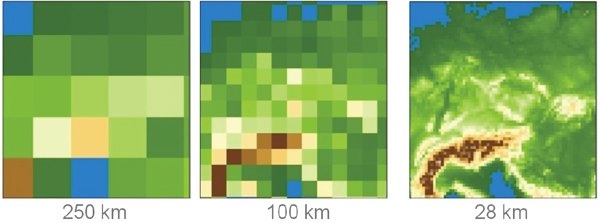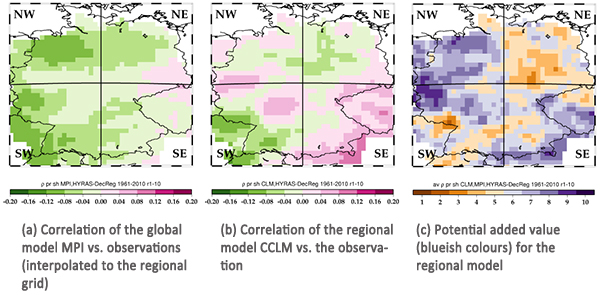ENVIRONMENT AND ENERGY
High-Resolution Climate Modelling
Principal Investigator:
Hans-Jürgen Panitz
Affiliation:
Institut für Meteorologie und Klimaforschung, Karlsruher Institut für Technologie (KIT)
Local Project ID:
HRCM
HPC Platform used:
Hermit of HLRS
Date published:
Atmospheric processes and climate change take place on all spatial scales: global, continental down to regional or local scales. Not only do processes on the different scales differ from each other but also regions exhibit various characteristics. Regional and local climate as such depends on small-scale structures such as urbanisation, land use, soil types, water surfaces, orography and vegetation.
Climate models are used to simulate the climate on the basis of physical laws described by mathematical equations, that are solved numerically. For this purpose the 3-D model region is partitioned into grid boxes. The grid boxes’ size describes the spatial resolution of the model and its processes. Due to computational restrictions the size depends on the overall size of the simulation area and cannot be decreased indefinitely.

Figure 1: Different spatial resolutions drawing on the example of Middle Europe
Copyright: © Karlsruhe Institute of Technology
Using global models (resolution from 100 to 300 km) one can make statements about the global and continental scale. However, more detailed information about specific regions or processes can only be obtained by using regional models. They allow to consider finer resolution as well as a more refined orography and the representation of small scale processes (Figure 1) but will only ever cover a limited area. To picture the whole range of possible climate developments, more than one simulation is necessary. Such ensembles can be derived by using different models, different boundary conditions or different configurations of one model.
Using the CRAY XE6 system at the HLRS high performance computing facilities a team of scientists at the Karlsruhe Institute of Technology (Research Group "Regional Climate and Water Cycle") aims to investigate the past, present and future climate of Central Europe/Germany and Africa with the climate version of the COSMO model (CCLM) of the German Weather Service (resolution from 50 to 1 km) within various research programs. Simulations of future climate utilise scenarios that take into account possible developments of population, economy and technical advancements.
Among other points the group wants to
- study the impact of future changes in regional and urban structures on the climate system
(REKLIM, G. Schädler, gerd.schaedler@kit.edu), - assess the impact of climate change on weather extremes (KLIMOPASS, K. Sedlmeier, katrin.sedlmeier@kit.edu) since reliable knowledge of the variability and changes in regional climate and extremes is crucial for the development and implementation of appropriate adaptation and mitigation strategies,
- investigate in processes and interactions involved in the regional hydrological cycle (i.a. CORDEX, H.-J. Panitz, hans-juergen.panitz@kit.edu),
- determine the potential of regional decadal climate prediction for Europe and the Monsoon region in Africa, which could be of great use to economical and governmental planning purposes (MiKlip, H. Feldmann, M. Uhlig, S. Mieruch´Schnülle, G. Schädler, N. Laube, H.-J. Panitz, Markus Breil, hendrik.feldmann@kit.edu).
The finer resolution of regional models as well as the need for ensembles and scenarios demand a great amount of computing time (up to 960 node hours for one simulation year) and data storage space (currently 2-3 TB per 10 year simulation time). This great effort is necessary, because regional climate cimulations show considerable improvement over global models when compared to observations (Figure 2). Especially extreme values e.g. of precipitation are often better simulated with regional models.

Figure 2: From Global to Regional: Gained Information shown via the average correlation coefficient of the summer-half precipitation from 1961-2010 over a ten member ensemble
Copyright: © Karlsruhe Institute of Technology
Scientific Contact:
Dr. Hans-Jürgen Panitz
Karlsruher Institut für Technologie (KIT)
Institut für Meteorologie und Klimaforschung, Bereich Troposphäre (IMK-TRO)
Hermann-von-Helmholtz-Platz 1, D-76344 Eggenstein-Leopoldshafen
e-mail: hans-juergen.panitz@kit.edu